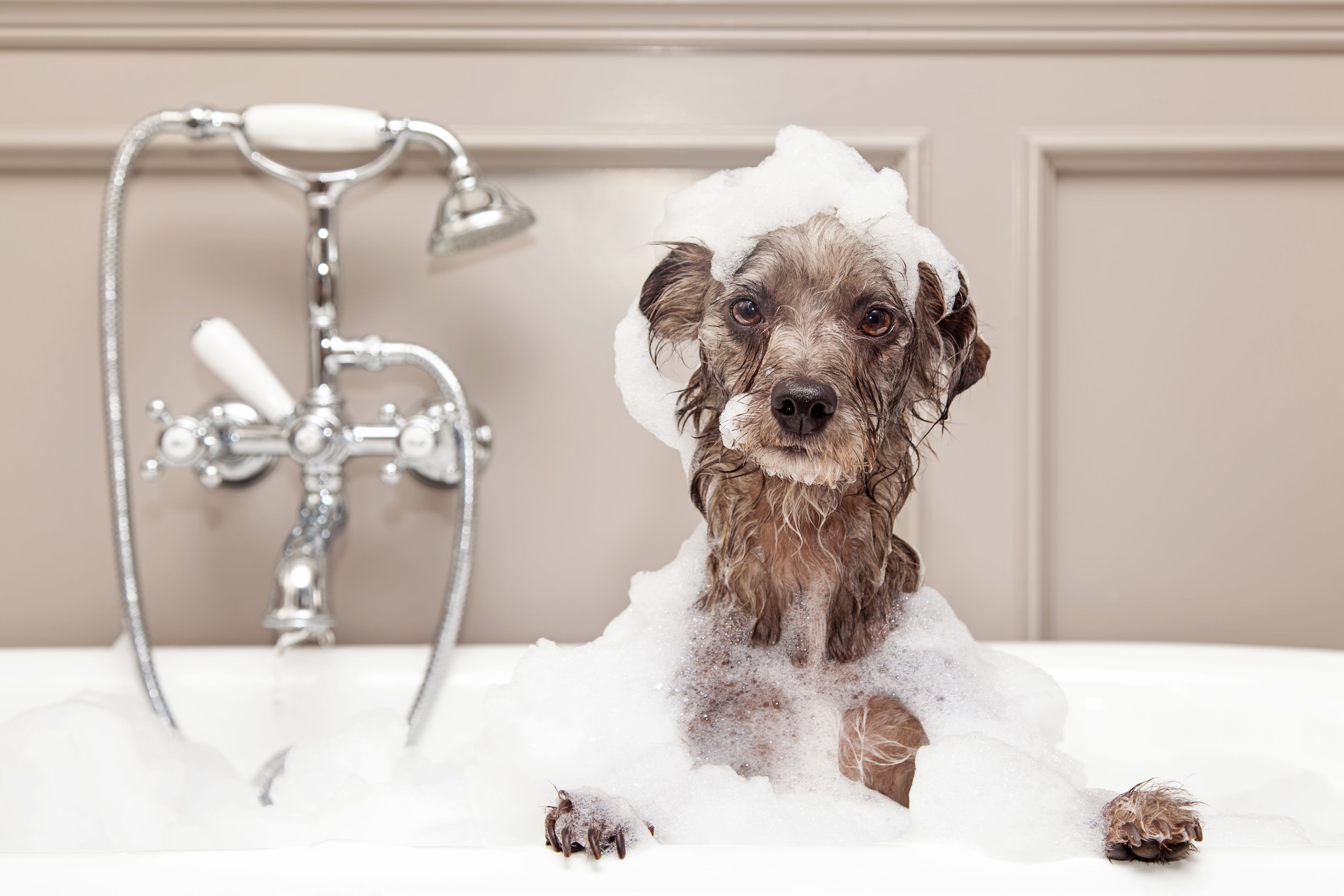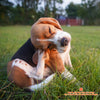Regularly grooming your dog helps to keep them happy and healthy; and it doesn’t have to be a struggle. Here’s what you need to know about grooming your furry friend.
Brush Their Coat
Regularly brushing your dog’s coat is important because it helps to keep their skin and fur clean and healthy. Not only does brushing help with de-matting and shedding, but it also distributes natural oils to keep the skin and fur shiny. While it’s no substitute for actually bathing your dog, brushing does help get rid of excess dirt and debris. It’s also a good opportunity to check for ticks and other unwanted critters!
So, the question is, how often should you brush your dog’s coat, and what tools do you need? Well, it depends on the type of coat your dog has!
Long-haired or curly-haired dogs need daily brushing with a rubber-bristled brush. Follow as needed by a comb through with a metal comb to get any leftover tangles out. The idea is to get down to the base of the hair shaft near the skin to dislodge forming mats, loose fur, and debris. You may also use a metal slicker brush for this purpose. It’s important to note that using sharper de-matting tools like slicker brushes and grooming rakes should be done sparingly, as daily grooming with these kinds of tools can irritate your dogs skin. Try Pet Spaw Pet Shedding Comb if you are looking for a good metal comb, or Wahl Dog Curved Slicker Brush, available in different sizes and with soft or firm pins.
It's important to remember that mats can become painful for your pets, so it's important to brush regularly to prevent them. Sometimes though, mats happen (especially in areas that a lot of rubbing happens, such as under the armpits). Because mats can be painful, usually the best course of action is to just cut them off. While it may not look pretty, it will be much more comfortable and pain free for your pup.
Shorter-haired dogs need the least maintenance. Brush them once per week with a rubber-bristled brush to get rid of loose fur and to distribute skin oils. If your dog has a double coat, depending on the time of year, it will likely need weekly de-shedding. Dog breeds such as German Shepherds, Golden Retrievers, Huskies, and Chow Chows, for example, commonly have double coats. You can tell if your dog has a double coat if it seems to have two different types of fur; a thicker and coarser overcoat and a finer, fluffier undercoat. Most dogs who have a double coat will often have that really big shed towards the end of winter (if you know, you know).
If your dog has a double coat, de-shed it weekly with an undercoat de-shedding rake or another similar de-shedding tool. Try Pet Spaw Long-Toothed Dematting Rake. Another great tool that is sure to really get those undercoats under control is a Furminator. Furminators come in a few different varieties depending on the type of coat that your dog has. These tools are GREAT for de-shedding as they really get into that dense under coat. As previously stated, it’s important to note that using sharper de-matting tools like Furminators, grooming rakes and slicker brushes should be done sparingly, as daily grooming with these kinds of tools can irritate your dogs skin.
Give Them a Bath
Bathing your dog will keep them, and your house, smelling great. If your dog has mats, brush/cut them out before bathing as getting the mats wet will make them worse. Not only will getting them wet make them harder to get out, but it can also make them smell unpleasant as mats tend to hold onto moisture VERY well. Most dogs need a bath once every month or two (unless they do something particulary messy). Before you bathe your dog, grab your supplies. A good shampoo and conditioner will enhance the health and appearance of your dog's fur. There are many different kinds of dog shampoos, and a lot of them have different uses. Good Dog has a line of shampoos that offers varieties such as puppy (this shampoo is a tearless formula that is gentle on your dogs fur and skin), deodorizing (for our friends who really like to roll around in the dirt!), whitening (for those breeds who want their white coat to really sparkle), calming (with soothing lavender and chamomile scents), soothing (made with oatmeal to help soothe dry, red skin), and refresh (to keep them looking their freshest!). You can find them here.
Deodorizing pet sprays are also great for keeping your dog smelling great between baths. Good Dog Deodorizing Pet Sprays come in several scents such as Cucumber Melon and Lavender Chamomile.
Trim Their Nails
If you let your dog’s nails get too long, they will cause pain and can even affect their gait. It's impotant to trim your dog’s nails every 3-4 weeks with a sharp pair of nail clippers or a rotary tool. Take care to avoid the quick (which is the pink part on the inside of the nail). Hitting the quick can not only be painful, but it can also bleed a lot and cause damage. Regular nail trims help to minimize the size and length of the quick. It's important that you have something to stop the bleeding if you do end up cutting into your dogs quick. Healthy Promise Pet Blood Stopper Gel is a good thing to have on hand just in case you do cut your dogs quick. Quicks tend to bleed and bleed, so it's important to get a handle on it *quick*ly.
For a good, sharp nail clipper, try Wahl Dog POWERGRIP Nail Clipper. The ultra-sharp blade cuts through nails easily and smoothly while the blade guide helps control the length of nail being trimmed for the safety of your pet.
Another option to cut your dogs nails is a rotary grinder with a safety cap such as Wahl Classic Nail Smoother. Rotary grinders get a smoother finish on a dogs nails, leaving less of a blunt cut and more of a rounded edge. A benefit of using the rotary ginders are that you are less likely to damage your dogs quicks because you are rounding out and grinding down the tip instead of giving the nail a blunt cut from the side.
Some pups are really sensitive about having their paws touched, which makes nail trims a lot more stressful than they need to be. It’s important to get your pup used to you touching their paws in a casual way from a young age so that they aren’t scared when you go to cut their nails. It's also important to be calm yourself, as your stress can also affect your dog! The more stressed you are, the more likely that mistakes will be made, which can potentially lead to injury.
Brush Their Teeth
Regularly brushing your dog’s teeth will help prevent plaque buildup, heart disease, costly dental work, and more. Brush your dog’s teeth every 2 - 3 weeks or more with a soft-bristled brush. Make sure to only use toothpaste made for dogs as human toothpaste can be extremely toxic for your dog. Sometimes, dogs will just see the big plastic toothbrush as a toy and try to bite it and play with it when it is in their mouth. It can be easier to have more control when you use a finger toothbrush (such as AFP Sparkle Finger Toothbrushes) or even a textured facecloth around your finger.
If your dog doesn’t like minty-flavoured dog toothpaste, try a food-flavoured one such as Bluestem Oral Care Chicken Flavor Toothpaste For Dogs And Cats. An added benefit of this toothpaste is that it has a thick and sticky texture that will stay on the toothbrush while brushing.
Some dogs will not accept brushing, and sometimes the brushing doesn’t totally fix their bad breath. Water additives are super beneficial to use for your pup as they help break down tarter buildup and prevent bad breath. One of our favourites is the Bluestem Oral Care Original Flavour Water Additive for Cats and Dogs. This product comes in three flavours (Original/Unflavoured, Vanilla Mint, and Chicken). For very picky dogs, we recommend starting out with the unflavoured variety as they will not be able to detect it in their water (sometimes new tastes in familiar things can be a little intimidating).
Wash Their Face and Ears
Neglecting your dog’s ears can lead to bacteria and wax build-up which may cause an infection (especially in breeds who have more compact sinuses). Clean your dog’s ears monthly with a tissue and an ear cleaning solution such as Enviro Fresh Ear Cleaner For Dogs & Cats. Enviro Fresh Ear Cleaner reduces dirt and wax and is gentle and soothing. To clean the ears, start with the outer ear flaps and gently work your way in.
If your dog is a breed that commonly has skin folds on its face, clean them regularly with a warm washcloth. This will prevent bacteria from building, and that bacteria can lead to infection or dermatitis (which can be itchy and stinky). While you have your warm washcloth in hand, wipe away any excess discharge from the eyes as well. Some breeds are prone to tear staining, especially on white fur. A product that we really like to help with tear stains is NaturVet Topical Tear Stain Remover With Aloe For Dogs & Cats. NaturVet Tear Stain Remover is a topical, gentle, water-based, wiping solution for removing tear and saliva stains from your pet’s fur. It prevents unsightly stains for a healthy coat and eyes.
Need more help with grooming? Visit your local Petland for grooming services!
Winnipeg:
Kenaston
Crossroads
Calgary:
Deerfoot Meadows
Crowfoot
Coventry Hills
South Trail
Shawnessy
Seton (SELF WASH)
Saskatchewan:
Victoria Gate (Regina) (SELF WASH)
British Columbia:
Prince George



